the place where Paleontology and Paleoanthropology meets Philately
Thailand
Dinosaurs and their fossils, prehistoric humans on stamps and postmarks of Thailand
| << previous country | back to index | next country >> |
Contents:
- Country overview
- Philately of Thailand
- Official stamps of Thailand to related to Paleontology
- Personalized stamps of Thailand to related to Paleontology
- Commemorative postmarks of Thailand to related to Paleontology
- References
- Acknowledgements
Thailand, officially the Kingdom of Thailand. A unified Thai kingdom was established in the mid-14th century. Known as Siam until 1939, Thailand is a country at the centre of the Indochinese peninsula in Southeast Asia.
Thailand is the only Southeast Asian country never to have been colonized by a European power.
The country covers approximately 513,000 km2 and has a population of around 70 million. The capital and largest city is Bangkok.
Thailand is bordered to the north by Myanmar and Laos, to the east by Laos and Cambodia, to the south by the Gulf of Thailand and Malaysia, and to the west by the Andaman Sea and Myanmar.
It also shares maritime borders with Vietnam in the Gulf of Thailand to the southeast, and Indonesia and India on the Andaman Sea to the southwest.
Thailand is a constitutional monarchy and has switched between parliamentary democracy and military junta for decades, the latest coup being in May 2014 by the National Council for Peace and Order. [R1]
Before Siam issued its first stamp, there was a limited mail service, mainly for the royal family. Domestic mail travelled by messengers while international mail travelled by steamboat to post offices in nearby countries, such as the Straits Settlements.
The earliest recorded mail from Bangkok dates back only to 1836 when American missionary Dan Beach Bradley sent a letter to his father in a stampless cover.
The first real postal service was established in Siam in 1880.
The Solot Series was the first series of definitive stamps issued by Thailand, on 4 August 1883, then known as Siam. [R2]
Official stamps of Thailand related to Paleontology: dinosaurs and its fossils
| 01.01.1992 "Department of Mineral Resources" [1] | 28.08.1997 "Dinosaurs" [2] | |
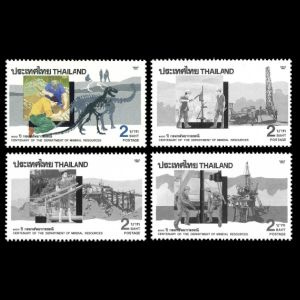 |
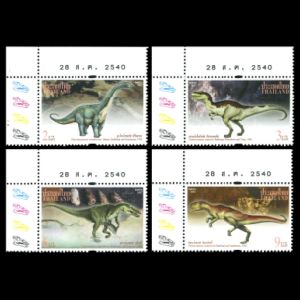 |
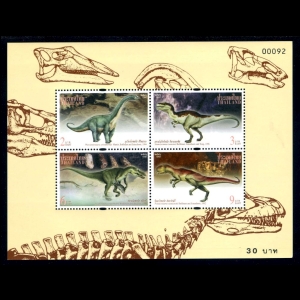 |
| 28.09.2004 "Unseen Tourist Attractions" [3] | 07.03.2008 surcharged [4] | |
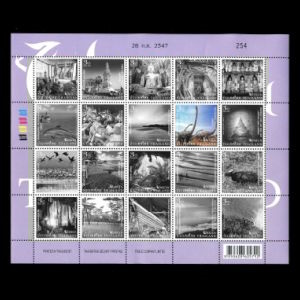 |
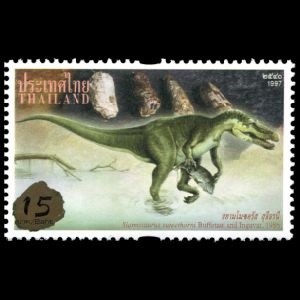 |
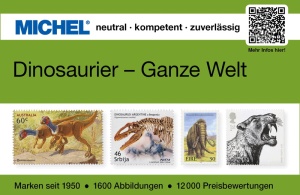 |
 |
| Dinosaur excavation on booklet stamp of Thailand 1992, MiNr.: , Scott: |
[1] Issued in sheets and booklets of 10.
[2] Issued in individual sheets of 20 stamp and common mini sheet. At least one stamp of the set issued in booklet of 5.
 |
| Phuwiangosaurus sirindhornae dinosaur on booklte stamps of Thailand 1997 MiNr.: , Scott: |
[3] The fourth stamp on the second row, shows a reconstruction of a group of dinosaurs at Phu Kum Khao Dinosaur Museum at Kalasin.
The reconstructions are likely individuals of Phuwiangosaurus.
This Museum is the first dinosaur fossil museum in Thailand and was established to study and research dinosaurs found in Thailand.
It also preserves fossils as reference material for future study and serves as an important geological tourism location in the country.
The Museum consists of a research building for dinosaur and other vertebrate fossils and an exhibit building. [R6]
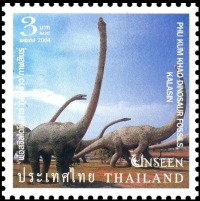 |
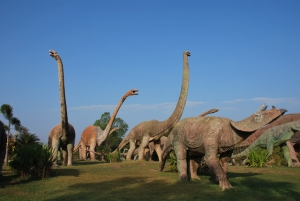 |
Phuwiangosaurus is a genus of Sauropod dinosaur from the Early Cretaceous.
It was a titanosaur which lived in Thailand.
Phuwiangosaurus was the first Sauropods dinosaur fossil-found in the Northeastern
part of Thailand.
Having both a long neck and tail, it measured about 15-20 meters in length.
The medium sized Sauropods had 4 legs and were vegetarians.
The type species was named to honor Princess Maha Chakri
Sirindhorn of Thailand, who was interested in the geology and palaeontology of Thailand.
Some sculptures of these dinosaurs are on display in the park at the Museum.
[R3]
[4] One of the stamps from 1997 "Dinosaurs" set was surcharged in 2008. The old value of 6 baht was replaced by the new value of 15 baht.
Some personalized stamps of Thailand related to Paleontology: dinosaurs
| 17.08.2012 "Dinosaurs collection" [P1] Issued by Rangsit Science Centre for Education |
09.10.2015 "UNESCO world heritage sites in south east Asia 2015" [P2] | |
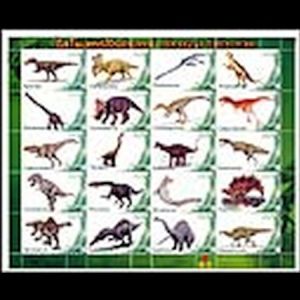 |
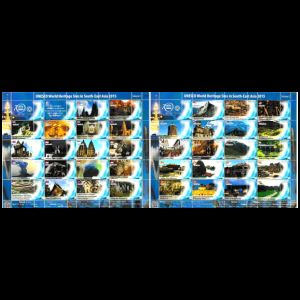 |
|
Notes:
[P1] The three–storey building of Rangsit Science Centre for Education comprises of 15 galleries, most of which are interactive and hands-on related to various science and technology themes, one of them is “Prehistoric World” which displays in 6 zones such as back to the past that we can learn about fossil and classes of rock, the formation of planet, the evolution of evolution of dinosaurs, mammals, reptiles, and the discovery of dinosaurs in Thailand. [R4]
[P2] The stamp set, released by Thailand Post in recognition of UNESCO’s 70th Anniversary that year, comprises two sheets of 20 stamps, with attached unique label, each featuring all 37 of South-East Asia’s (not only Thailand’s) World Heritage sites.
The stamp sheets include some photos that highlight the diverse and culturally rich World Heritage treasures of the region.
A QR code on each stamp sheet also links to the World Heritage website for further information about the sites. The face value of every stamp is 3 baht.
Sangiran man skull (Homo erectus) can be seen on one of the labels on one of the sheets.
Fossilized skeleton of Perak Man (Homo sapiens) can be seen on one of the labels on the other sheets.
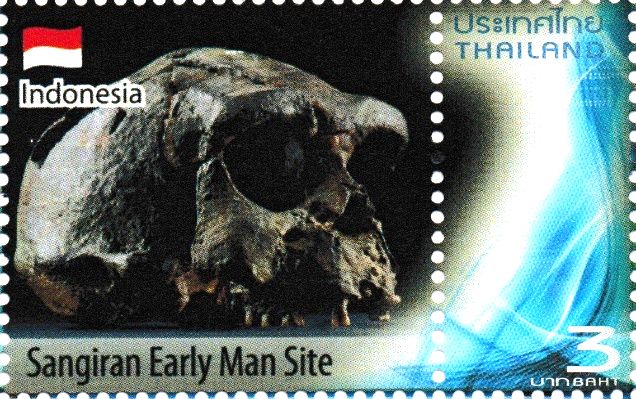 |
| Sangiran man skull on personalized stamp of Thailand 2015 |
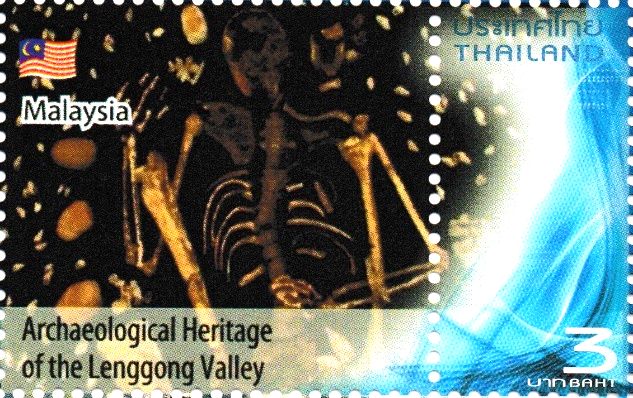 |
| Fossilized skeleton of Perak Man on personalized stamp of Thailand 2015 |
Sangiran Early Man Site is situated about 15 kilometres to the north of Solo town
in Central Java, Indonesia, covering an area of 5,600 hectares.
It became famous after the discovery of Homo erectus remains and associated stone artifacts
(well-known as Sangiran flake industry) in the 1930s.
There is a significant geological sequence from the Upper Pliocene to the end of the Middle Pleistocene
at the site. The sediments host human and faunal remains from the last 2.4 million years – and serve
as a record of cultural evolutions in the region.
The property also yields important archaeological occupation floors dating back to the Lower
Pleistocene around 1.2 million years ago.
Sangiran is one of the key sites for the understanding of human evolution.
[R5]
"Perak Man" is the name given to the skeletal remains of a man (Homo sapiens) thought to have lived about
11,000 years ago in the Lenggong Valley district of Hulu Perak.
It is the oldest human skeleton found so far in Peninsular Malaysia.
The remains were discovered in 1991 in a cave called Gua Gunung Runtuh, a few kilometres north of the town of Lenggong and 105 meters above sea level.
The skeleton and other exhibits found in the Lenggong Valley area are now showcased in a museum, the Lenggong Valley Archaeological Gallery
at the village of Kota Tampan, just south of Lenggong.
[R7]
Commemorative postmarks of Thailand related to Paleontology: dinosaurs
Legend is here| 28.08.1997 "Dinosaurs" [FDC] | ||
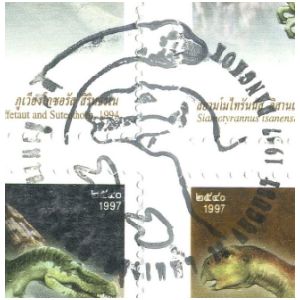 < < |
|
|
References:
- [R1] Thailand: Wikipedia FlagCounter
- [R2] Postal History and Philately of Thailand:
Wikipedia
Links to official website of the Post Authority, stamp catalog and a list of new stamps of Thailand are here - [R3] Phuwiangosaurus: Wikipedia.
- [R4] Rangsit Science Centre for Education: official website.
- [R5] Sangiran Early Man Site: UNESCO.
- [R6] Phu Kum Khao Dinosaur Museum: Wikipedia.
- [R7] Perak Man: Wikipedia, Malaysia Traveller.
Acknowledgements:
Many thanks to
- a fellow collector Pteter Brandhuber from Germany for his help finding images and information about personalized stamps of Thailand 2015.
- Dr. Peter Voice from Department of Geological and Environmental Sciences, Western Michigan University, for the draft page review and his valuable comments.
| << previous country | back to index | next country >> |